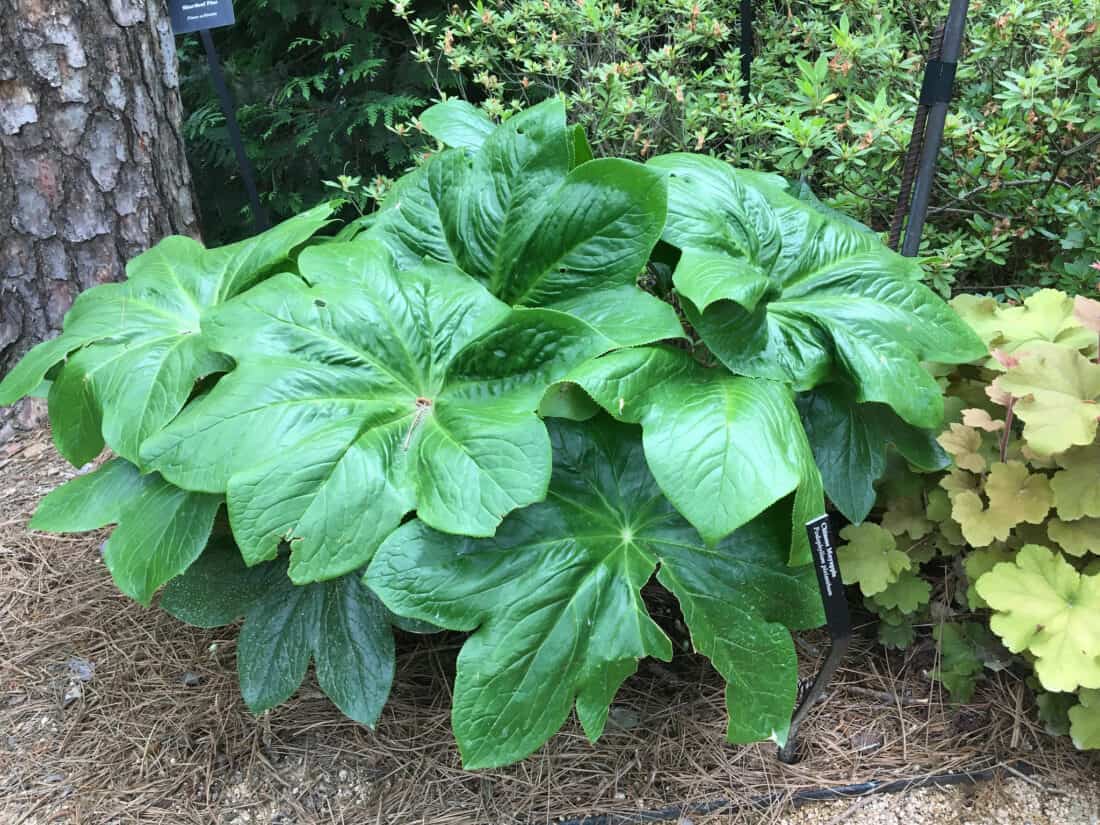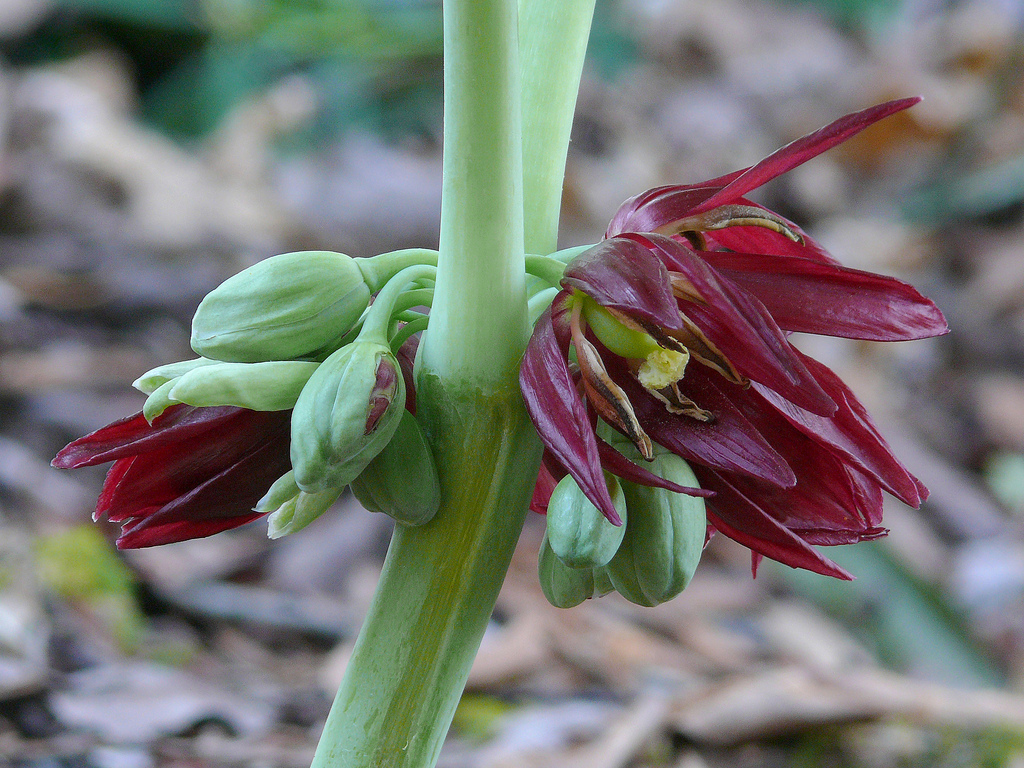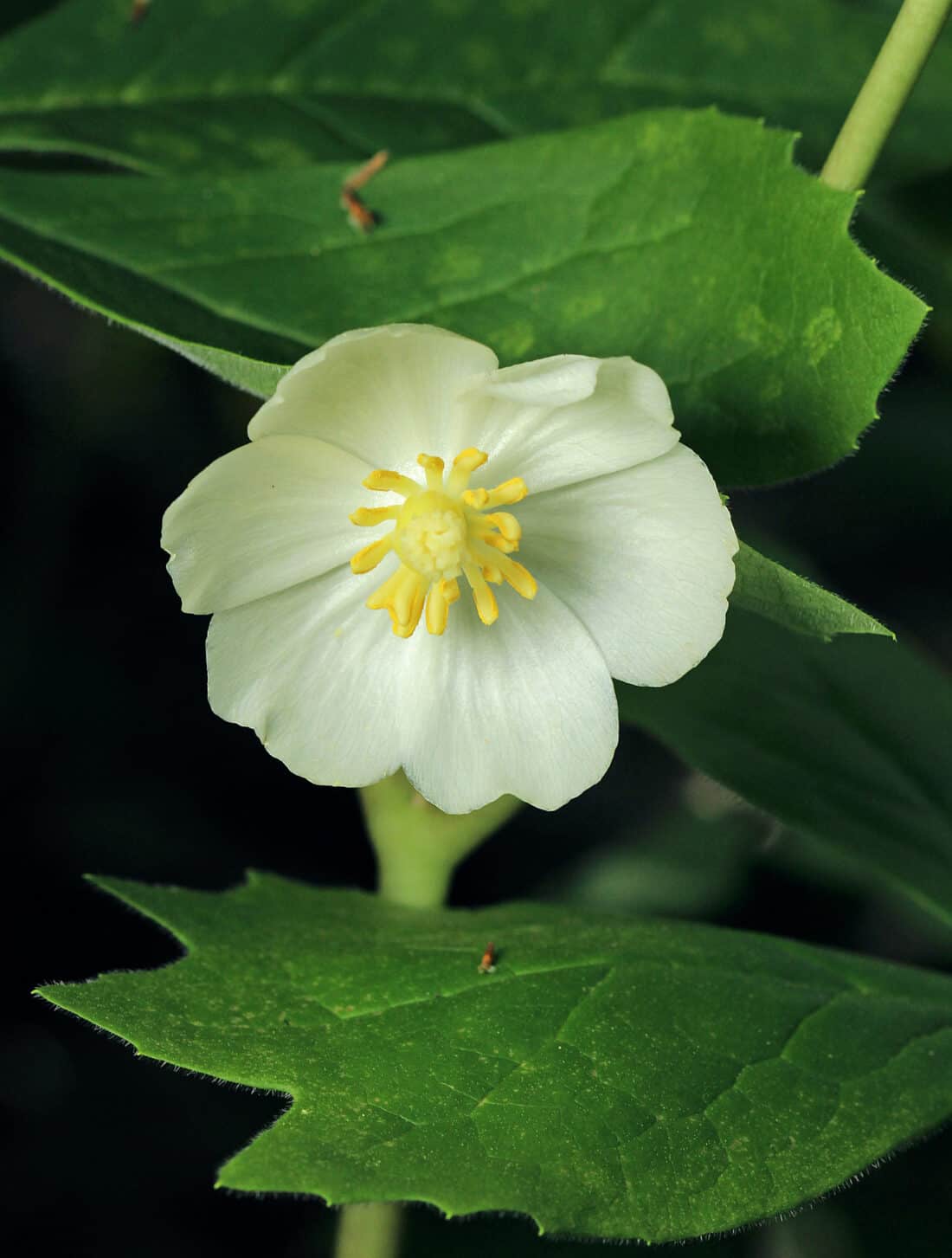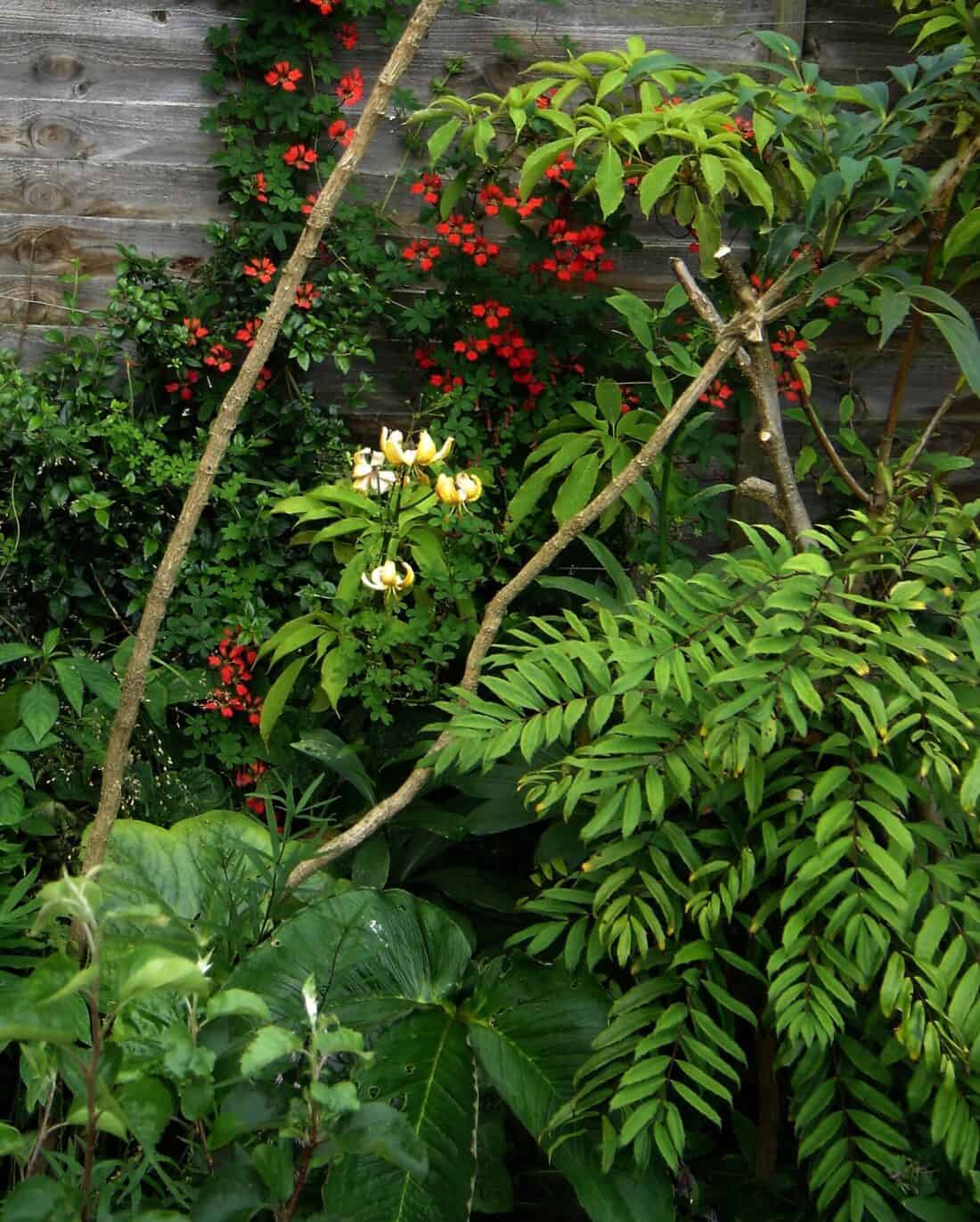As I was walking through the gardens last week, I noticed a large, glossy-leaved plant with big, yellow-green fruit hanging from underneath the leaves. There were probably 20-30 of these egg-shaped fruits hanging in clusters under the leaves. It really was a cool sight to see. As I got closer, I realized this was the Chinese mayapple, or Podophyllum pleianthum. The Chinese mayapple is similar to our native mayapple, Podophyllum peltatum, with some noticeable differences.

Mayapples and Summer Dormancy
The Chinese mayapple does not go dormant in the summer. The US native mayapple is native to eastern North America, where the Chinese Mayapple is from China. Both are commonly found in a woodland garden, but where the native wildflower emerges in the early spring and then goes through a mid-summer dormancy – the Chinese version stays green and leafy throughout the growing season.
A Difference in Size
Another difference is the size. The height and spread of the Chinese plant can be up to twice the size of our native mayapple. Both are spread by underground rhizomes, and both form large colonies. Also, the leaves are dark green and shiny on the Chinese species versus the matte green appearance of our native P. peltatum. I love our native mayapple, but I also think that incorporating the Asian species into the garden adds a nice contrast.

Mayapple Fruits and Flowers
For both plants, the fruit – which emerges beneath the umbrella-like leaves – has provided powerful medicinal tools to their nearby indigenous communities. The Native Americans in the United States used Mayapple for medicinal purposes, including treating warts and as a purgative. Please use caution. Most of this plant is toxic. The plant does, however, produce fruit with a lemon-like flavor that is edible when fully ripe. (But again – all other parts are toxic!) Mayapples, which are found in open woodlands, are often associated with magic and folklore, with some Native American tribes considering them sacred.
In China and the Himalayas, native mayapples have been used in traditional Chinese medicine, and various parts of Podophyllum hexandrum (a similar and related variety of podophyllim) are used for their potential anti-cancer properties.

Designing with Mayapple – Podophyllum
Podophyllum pleianthum is known for its large, showy, maroon or purple flowers and striking floral display. The native Podophyllum peltatum variety has a pale green and rose-colored flower – but it is nowhere near as exciting visually. Both varieties thrive in abundant organic matter and full shade.
As a designer, I am inclined to take some inspiration from a plant when I look for plant partners. The Flower of the native mayapple has green sepals, yellow anthers, and white filaments and reminds me of hellebores. I’d consider them as potential partners. The Flower of the Chinese Mayapple, conversely, reminds me of phlomis or fritillaria rubra. See below for a full list of potential plant partners.
As design goes – there are always two main and primary considerations – looks and ecological services. Planting the native mayapple means that you will be helping provide more ecosystem services. The ripe fruits of native mayapple is a food source for box turtles.
May Apples in New England Gardens
For us here along the Maine coast, having the big, almost tropical-like appearance of the Podophyllum pleianthum is a striking addition to our dry-shade garden areas. From what I am learning about the plants, they resent being in areas that stay wet or being in too much sunlight.
Once you plant them in dry shade, be sure to water frequently until established. During periods of dry weather, I would be sure to give them a supplemental drink or two of water. They will continue to look great in the gardens until our first hard frost, which typically comes in late October. That turns out to be around six months of interesting foliage in the gardens.
If you are adventuresome, be sure to have your guests crawl on the ground in late spring to see the attractive, deep red flowers (or plant them in an elevated area so we can see under the leaves!). Unfortunately, the flowers are usually hanging under the big foliage so they are hard to see. As mentioned above, in the fall, they produce attractive yellow-green fruit over an inch long and half as wide.

Planting Ideas for Podophyllum (Either the Chinese variety or the Native Variety).
Other options for plant partners for either Podophyllum peltatum (North American Mayapple) or Podophyllum pleianthum (Himalayan/ Chinese May apple):
Foliage Plants to Combine with Podophyllum:
- Hostas (Hosta spp.): These shade-loving perennials come in various sizes and leaf colors, creating a dynamic contrast.
- Ferns (Various species): Shade-loving ferns, such as ostrich fern or maidenhair fern, can create a lush and textured backdrop.
- Coral Bells (Heuchera spp.): With their diverse foliage colors, Coral Bells create visual interest and can tolerate partial shade.
- Epimedium (Epimedium spp.): Also known as barrenwort, it’s a low-maintenance ground cover with unique foliage that complements the Chinese Mayapple.
- Japanese Painted Fern (Athyrium niponicum var. pictum): Its silvery fronds add a touch of elegance and contrast to the bold leaves of the Himalayan Mayapple.
- Heucherella (Heucherella spp.): This hybrid between Heuchera and Tiarella offers a variety of leaf colors and complements the bold foliage of Podophyllum pleianthum.
- Bergenia (Bergenia spp.): With its bold, leathery leaves and early spring flowers, Bergenia creates a robust and textured look in the garden.
- Kirengeshoma Palmata: This is a signature plant in my gardens – it is a great accent or focal point in any shade garden.
Blooming Woodland Plants:
- Trillium (Trillium spp.): These native woodland plants share similar growing conditions and provide additional spring interest.
- Virginia Bluebell (Mertensia virginica): With its blue flowers, it complements the white flowers of Mayapples and thrives in similar conditions.
- Astilbe (Astilbe spp.): The feathery plumes of Astilbe add texture and color to the shade garden, complementing the Mayapple’s umbrella-like foliage.
- Hellebores (Helleborus spp.): These evergreen perennials provide early spring blooms and thrive in similar shaded environments.
- Bleeding Heart (Dicentra spp.): The delicate, heart-shaped flowers add a graceful touch to the understory where the Chinese May apple grows.
- Fothergilla (Fothergilla spp.): This deciduous shrub offers beautiful fall foliage and thrives in partial shade, enhancing the overall garden aesthetic.
- Rhododendrons and Azaleas (Rhododendron spp.): These flowering shrubs provide a burst of color and thrive in similar acidic soil conditions.
Update (2023) – I planted podophyllum Spotty Dotty in my Garden this summer. It was a gift from Matt Mattus. Spotty Dotty is a hybrid of several Asian May apples. Its leaves are chartreuse and choco-late brown (spotted, of course), and it has large dark red flowers. I planted it in what I think is the perfect spot – I’ll let you know how it goes.
Also – I was wondering if the apple fruit is edible. And yes – apparently, it is. I’ve not tried it, but I found descriptions of it as both bland and also tasting like a pineapple starburst. This seems a large spectrum and I will let you know my own original take on the flavor when I have some fruit to harvest and taste myself.
If you have Mayapple fruit you can use them in a variety of recipes (smoothies, syrup, pancakes, jellies)
Other Related Posts:
I saw the Chinese mayapple for the first time while on a garden tour last year. I didn’t notice the flowers at first but when I did, I pointed them out to my companions. That sent a whisper down the lane and soon everyone was standing with their heads upside down or crouching down to get a better view. Such an interesting plant!
That is a great story, Kathryn! Thanks – re
Funny thought of folks peeping under the leaves to see the fruit. These are great plants (pricey) but they do get larger with age. For larger leaves and more root establishment take the fruit off from beneath (besides your friends’ won’t normally peep under the leaves to see the little green “eggs” after the flowers drop off…). They will suffer in really DRY and hot wind so keep them sheltered and watered as needed…
Wow Pineapple Starburst!? That’s incredible & not far off from American Mayapple with Sweet Tropical Passionfruit flavors. Have you finally tried the fruit? Was it similarly sized to American Mayapples? Flesh juicy or dry? Could it be that those who described it bland ate the not fully ripe fruits?
I haven’t tried it yet – It hasn’t actually produced fruit yet… (only one year since transplanting)